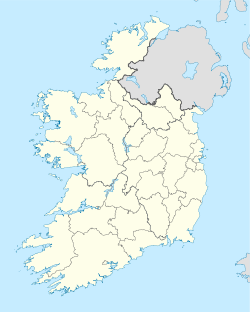- Donegal Corridor
-
Donegal Corridor — Region — Location in Ireland Coordinates: 54°30′05″N 8°12′06″W / 54.5015°N 8.2018°WCoordinates: 54°30′05″N 8°12′06″W / 54.5015°N 8.2018°W Country Ireland Province Ulster County County Donegal Time zone WET (UTC+0) - Summer (DST) IST (WEST) (UTC-1) Irish Grid Reference G874616 The Donegal Corridor was a narrow strip of Irish airspace linking Lough Erne to the international waters of the Atlantic Ocean through which the Irish Government permitted flights by British military aircraft during World War II. This was a contravention of Irish neutrality and was not publicised at the time.
Contents
Background
When the Second World War broke out in September 1939, Ireland was in no position to become involved. In fact some years beforehand the deValera-led government had declared a policy of neutrality. This was supported by the opposition parties.
The Battle of the Atlantic commenced soon after war was declared. German U-boats attacked Allied shipping convoys in the Atlantic Ocean, where hundreds of ship were sunk and thousands of lives lost, resulting in a very serious situation for the Allied forces. In December 1940 a survey was carried out on Lough Erne with a view to having flying boat bases built there. This was the most westerly point in the United Kingdom from where planes could patrol the Atlantic and offer some protection to the shipping convoys against the dreaded U-boats. Early in 1941 the first flying boats were based on Lough Erne. They were not permitted to fly over the territory of Éire. This meant that they had first to fly northwards then change their flight path and go west.
Some limited protection could be given to the convoys coming to the UK from the U.S. and Canada, the same protection could be given by American-based aircraft. Still there was a gap where the U-boats could create havoc unhindered. This mid-Atlantic area was known as the Black Gap. Ireland came under extreme pressure from the British and even the U.S.A. who at this time were themselves neutral to dispense with its neutrality policy and join with the Allies. A meeting took place in January 1941 between deValera and Sir James Maffey, the British representative in Dublin. An agreement was reached whereby the Lough Erne-based flying boats were permitted to fly across a four-mile stretch of neutral territory from Belleek in County Fermanagh to Ballyshannon in County Donegal and thereby gain access to the Atlantic Ocean. To pacify the Germans these aircraft were supposed to follow a defined route and then only on air/sea rescue missions.
This flight path became known as 'The Donegal Corridor'. The original agreement and rules were soon changed and the flying boats went on missions to the mid-Atlantic, to the west coast of France and to Iceland to protect convoys on those routes. This was a turning point in the Battle of the Atlantic which was the longest battle of the Second World War. Some nine U-boats were confirmed as having been sunk by the Lough Erne Sunderland and Catalina flying boats and many others so badly damaged that they had to return to base in France. One of the most famous sorties was that of a Lough Erne Catalina that spotted the Bismarck when it was escaping to France.
One such concession, in January 1941, was permission for British warplanes to overfly Irish territory en route to Atlantic patrols, thus allowing flying boats based at Lough Erne, in Northern Ireland, a direct route to the sea instead of the previous route via Derry. This allowed greater reach for air patrols to protect convoys from U-boat attack and reduced the "Atlantic Gap" where convoys were at their most vulnerable. The agreement, which was concluded in the The Cranborne Report), was secretly made between Éamon de Valera and Sir John Maffey, Britain's representative in Ireland.[1]
Location
Between Lough Melvin in Co Leitrim and the River Erne in Co Donegal, Co Donegal narrows and separates the Northern Irish Co Fermanagh from Donegal Bay and the Atlantic. The seven mile long Corridor was between Belleek and the coast beyond Ballyshannon, along the course of the River Erne[1]
The base itself was at RAF Castle Archdale.[2]
Use
The first official flight along the Corridor was on February 21, 1941[1] by No. 240 Squadron RAF's Supermarine Stranraer flying boats. Conditions of the concession included that flights should be made at a "good height" and that aircraft should not fly over the military camp at Finner; these conditions appear to have been ignored by both sides.[2][3]
A notable episode was when a Consolidated Catalina flying boat from No. 209 Squadron RAF based at Lough Erne located the German battleship Bismarck in 1941, leading to the ship's destruction.[4]
By the end of the war, 320 men had died in 41 missions by flying boats based at Lough Erne. In 2007, memorial plaques were unveiled in Counties Donegal and Fermanagh.[1]
See also
References
- ^ a b c d Guidera, Anita (April 19, 2007). "Plaques mark secret wartime air corridor in Donegal". Irish Independent. http://www.independent.ie/national-news/plaques-mark-secret-wartime-air-corridor-in-donegal-44249.html. Retrieved 2008-09-04.
- ^ a b McGowan, Joe (March 2005). "Irish Neutrality: Sacred Cow or Pious Wish?". SligoHeritage. http://www.sligoheritage.com/history(shannon).htm. Retrieved 2008-09-04.
- ^ "My Mother, the Flying Boat Expert (see Message 1 - Sunderlands)". http://www.bbc.co.uk/ww2peopleswar/stories/48/a1362548.shtml. Retrieved 2009-12-17.
- ^ Kennedy, Ludovic (1975). Pursuit: The Sinking of the Bismarck. London: Book Club Associates. pp. 137.
Categories:- Politics of World War II
- Politics of the Republic of Ireland
- Foreign relations of the Republic of Ireland
- Independent Ireland in World War II
- Battles and operations of World War II involving Ireland
Wikimedia Foundation. 2010.

